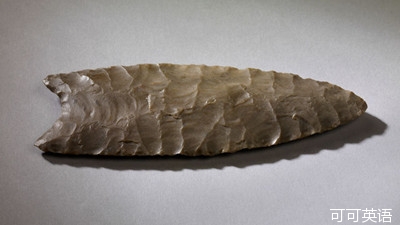I'm in the North American gallery of the British Museum, among the magnificent feather headdresses, and in a case beside the totem poles, is a very interesting bit of rubbish indeed. It is the business end of a deadly weapon; a spear - the shaft, of course, is long gone.
在大英博物館的北美洲展館部分,眾多五彩繽紛的羽毛頭飾與華麗壯觀的圖騰柱中間,一顆不起眼卻很有趣的小“垃圾”靜靜地躺在一個小展臺上。它便是一件致命武器的最尖端。這根長矛的矛桿當然早就腐朽在漫漫歲月中了。
It's made of stone and it was lost by a person like you or me in Arizona over 13,000 years ago.
一萬三千年前,這石制矛頭被某個像你我一樣的人類遺棄在亞利桑那州。
The spearhead is made of hard flint and it's about the size of a small, slim mobile phone, but it's in the shape of a long thin leaf. The point is still intact and still very sharp. The surface of both sides has beautiful ripples and, when you look closely, you can see that these are the scars from its making, where the flakes of the flint have been carefully chipped off.
這矛頭是由一顆堅硬的燧石制成的,大概一部超薄手機大小,細細長長的葉子狀。它的矛鋒完好無損,仍然相當的尖銳。表面的兩側有美麗的漣漪痕跡。細細觀察下來,就可以看出那是打磨過程中留下來的。當年工匠精工細磨,慢慢地在這燧石片上敲下片片碎石,就留下了道道的痕跡。
It's a lovely thing to touch and it's very well adapted to its lethal purpose - a thing of beauty and a kill forever!
它把弄起來玲瓏可愛,但卻十足勝任了它生來賦于的致命使命——永恒的美麗、永恒的兇器!
This spearhead raises many questions. But perhaps the most surprising fact is that it was found in America. After all, for most of our history we humans have been a resolutely land-locked African, Asian and European species. So how did the people who made spears like this get to America, and who were they?
這矛頭引出了許多問題。但也許其中最讓人吃驚的一點是它出土于美洲。畢竟在我們歷史的絕大部分時期,人類這物種總是生存繁衍在非洲、亞洲及歐洲等內陸地區。當然,當初這些制造類似這種長矛的人類,是如此到達美洲的?他們又是誰呢?
This stone spearhead is by no means unique; it is just one of thousands that have been found across North America, from Alaska to Mexico. They're known as Clovis points, after the small town in the US State of New Mexico where they were first discovered in 1936, alongside the bones of the animals they'd killed. And so the makers of these stone points, the people who hunted with them, are known as Clovis people.
這石矛頭決不是獨一無二的,僅僅是幾千件之一;出土的大量石矛頭遍布了從阿拉斯加到墨西哥的北美各地。它們被稱為克洛維斯尖矛頭,根據它們首次出土地的那個美國新墨西哥州小鎮命名;當時隨之出土的還有被這些矛頭殺害的動物骨頭殘骸。因此,這些石制矛頭工匠們及其他們的同伴,那些一起狩獵的人類,被稱之為克洛維斯人。
The discovery at Clovis was one of the most dramatic leaps forward in our understanding of the history of the Americas. These spearheads are the firmest evidence yet found for the first human beings to inhabit America.
克洛維斯大發現在對我們美洲歷史的認知上,可謂是一個最戲劇性的飛躍。這些矛頭是有史以來證明美洲首批人類定居蹤跡的最有力證物。
Almost identical Clovis points have been found in clusters from Alaska to Mexico, and from California to Florida, and what they show is that these people were able to establish small communities right across this immense area as the last Ice Age was coming to an end, about 13,000 years ago.
從阿拉斯加到墨西哥,從加利福尼亞到佛羅里達州,成批成批的克洛維斯矛頭相繼出土,幾近相同。它們向我們說明了,大概在最后一次冰河時期即將結束的一萬三千年前左右,這些人類已經能夠在北美這廣寬無垠的土地上建立起一處處小聚居的部落。
Are the Clovis people really the first Americans? The leading expert in this period is Professor Gary Haynes:
這些克洛維斯人是否是真正的北美人呢?這時期的領頭學者加里·海恩斯教授說道:












